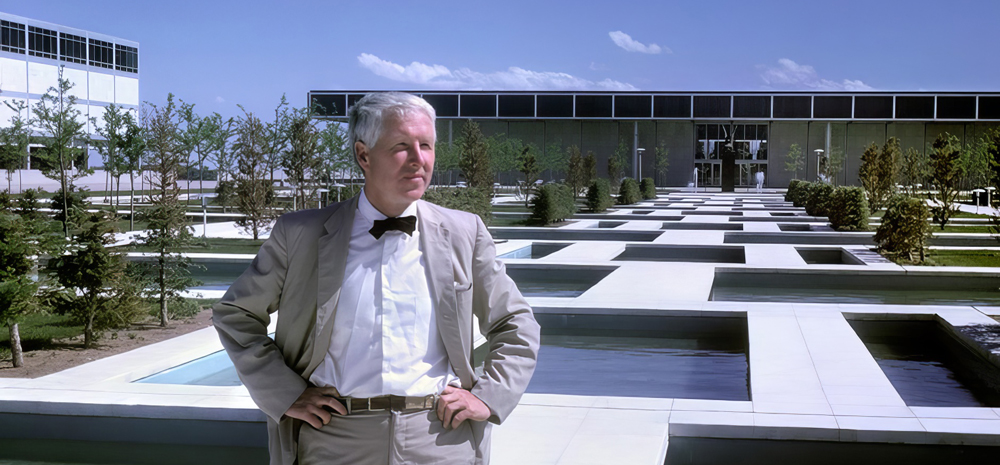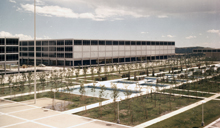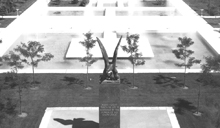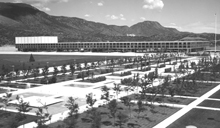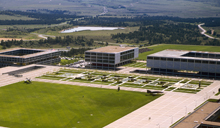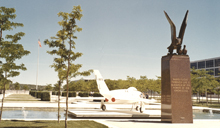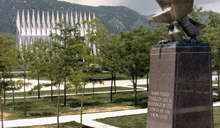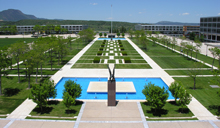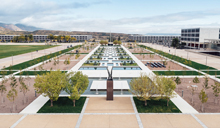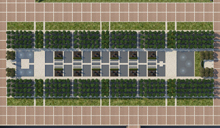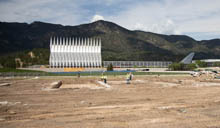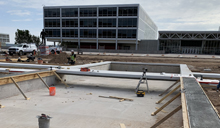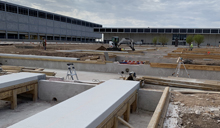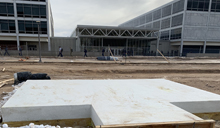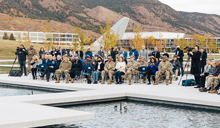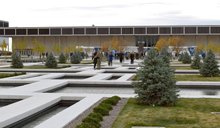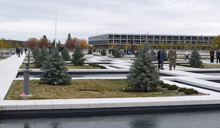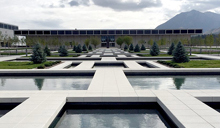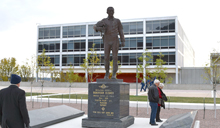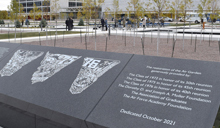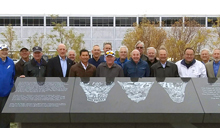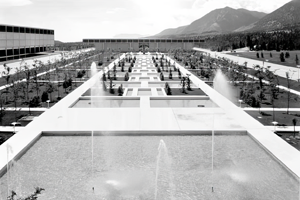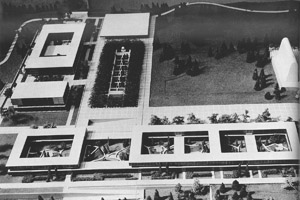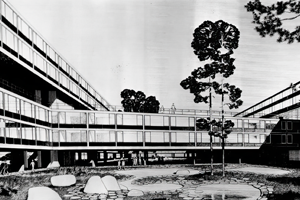March 2017
Classmates, at our 40th Reunion, the class formed and charged a Gift Committee to select suitable gifting to the Academy for our 45th Reunion. Accordingly, classmates Fariss, Beesley, Pyatt, Hennek, and Smith-Harrison selected two gifts that were endorsed by our class officers: Endowing Contrails and Restoring the Air Garden. We wanted gifts that would last for our lifetimes, are important to the Academy, and affects all past, present and future cadets. After considering over 20 candidate gifts, we unanimously selected these two iconic USAFA treasures.
Contrails is still heavily used in fourth class training but the funding for publishing it has proven problematic for the Academy over the years. The class that gifts this publication not only helps the Academy but makes a lasting mark on every future cadet entering USAFA. The Class of 1975 will be recognized in each future edition with our class crest and an address to the new class on a cover page.
The Air Garden is not what we remember. Over the years they have suffered from lack of attention, with reduced water features, deteriorated vegetation and broken marble strips. The desire is to restore the Air Garden with the fountains and landscape as close to the original design as possible. The Class of 1975 will be recognized for their contribution in this project with a permanent oblast mounted plaque placed on the grounds of the Air Garden.
Our "stretch goal" for this gift is $1,975,000 with the first $200K funding the Contrails endowment and the balance applied to the Restoration of the Air Garden. We intend to measure the success of our campaign by class participation, not a dollar amount but we wanted to know if we were at least in the right ball park. So we validated the stretch goal by contacting 30 classmates to gauge class interest. Their response for these two iconic gifts was overwhelming as this small sampling have already made pledges totaling $800,000!
We will conduct a class wide funding campaign commencing April 2017. This will be done with a classmate in direct contact with each classmate. Both projects will be completed before the Class of 1975’s 45th Reunion in 2020 when we will be able to stroll through a restored Air Garden and be recognized together, as a class, in Falcon Stadium for providing one of the best gifts in Academy history!
Thanks for the opportunity to serve our class, respectfully yours,
The Class of 1975 Gift Committee: Larry Fariss / Mark Beesley / Rick Pyatt / Rod Hennek / Leon Smith-Harrison
December 2018
Classmates, as many of you know, at our 40th Reunion the Class formed and charged a Gift Committee to select suitable gifting to the Academy for our 45th Reunion.
Accordingly, classmates Fariss, Beesley, Pyatt, Hennek, and Smith-Harrison initiated a “Quiet Phase” of a campaign by selecting two gifts that were endorsed by our class officers: Endowing Contrails and Restoring the Air Garden. We wanted gifts that would last for our lifetimes, are important to the Academy, and affects all past, present and future cadets. After considering over 20 candidate gifts, we unanimously selected these two iconic USAFA treasures.
Contrails is still heavily used in fourth class training but the funding for publishing it has proven problematic for the Academy over the years. The class that gifts this publication not only helps the Academy but makes a lasting mark on every future cadet entering USAFA. The Class of 1975 will be recognized in each future edition with our class crest and an address to the new class on a cover page.
The Air Garden is not what we remember. Over the years it has suffered from lack of attention, with reduced water features, deteriorated vegetation and broken marble strips. The desire is to restore the Air Garden with the fountains and landscape as close to the original design as possible. The Class of 1975 will be recognized for their contribution in this project with a permanent oblast mounted plaque placed on the grounds of the Air Garden (see Air Garden Design Renderings and Gallery, Below) .
The Quiet Phase Committee selected an overall "stretch goal" of $1.975M, with the first $200K funding the Contrails endowment and the balance applied to the Restoration of the Air Garden. We intended to measure the success of our campaign by class participation, not a dollar amount but we wanted to know if we were at least in the right ball park. So we validated the stretch goal by contacting 30 classmates to gauge class interest. Their response for these two iconic gifts was overwhelming as this small sampling have already made pledges totaling $800,000! Many thanks to them and the Quiet Phase Committee members who worked so diligently on our behalf to this point!
With that great start, we are now entering the “Public Phase” of the campaign with a new committee consisting of classmates Larry Fariss, Rick Pyatt (1st Group), Mark Volcheff (2nd Group), Bentley Rayburn (3rd Group) and Duane Jones (4th Group), who will conduct a class wide funding campaign commencing January 2019. This will be done with a squadron mate in direct contact with each classmate. We are seeking to complete our pledges to the Class Gift Campaign by 4 June 2019. Both of our selected projects will be completed before the Class of 1975’s 45th Reunion in 2020 when we will be able to open a current Contrails, stroll through a restored Air Garden and be recognized together, as a class, in Falcon Stadium for providing one of the best gifts in Academy history!
Thanks for the opportunity to serve our class, respectfully yours,
The Class of 1975 45th Reunion Gift Committee:
Quiet Phase: Mark Beesley / Rick Pyatt / Larry Fariss / Rod Hennek / Leon Smith-Harrison
Public Phase: Larry Fariss / Rick Pyatt / Mark Volcheff / Bentley Rayburn / Duane Jones
December 2019
Dear ’75 Classmates:
Season's greetings from Colorado! Here's an update of our 45th Reunion Class Gift Campaign in support of funding Contrails and Renovation of the Air Garden. First and foremost, as campaign chair, I would like to offer a special thanks to all in our class who have already generously contributed! I am pleased to relay that, to date, 44.1% of our class has contributed and we have raised $1,170,584.24 of the class's stretch goal of $1,975,000. Of that total, $201,287.50 has been endowed for Contrails and $969,296.74 earmarked for the Air Garden.
Here is an update for each project:
The Contrails Class Gift is completed, and we have presented the past four classes (2020-2023) with their personal copy that includes the following prominently displayed Class of 75 Commemorative page HERE. The Contrail funds are invested with the Endowment and structured to fund the publication of Contrails in perpetuity. We can be very proud of this accomplishment which is the envy of many classes who wanted to do the same. We beat 'em to the punch!
The Renovation of the Air Garden is a much bigger task that continues to make steady progress. The Academy remains committed to completing this important and long overdue renovation. The contract responsibility and project oversight has recently shifted from the Academy to the Endowment. This is good news as the Endowment has successfully completed similar projects (Holaday Athletic Center and Falcon Stadium Locker Rooms) on behalf of the Academy with less overhead and red tape involved. The funding for the Air Garden Renovation (approx. $6M), is provided by class gifts from '72, '75 and '76 and support from the Endowment. With strong ongoing class gift campaigns in place, the Endowment has confidently stepped out by hiring a project officer to oversee the renovation and re-letting the contract out for bid. The new timeline is for contract acceptance by the end of CY2019; the Air Garden pools and plumbing work to be completed by Fall 2020; and the landscaping to be installed in the Summer of 2021.
So what’s next? With both projects on track, and our 45th Reunion around the corner in 2020, let’s make a final push to reach our stretch goal of $1.975M! Here is a thought:
Over the course of the last 44 years, 75% of our class has donated back to the Academy!
I would like to challenge each squadron and group to close this campaign out with reaching that historic 75% participation rate. After all 75 is our number, and it only takes a few more of us per squadron to hit that figure and enable us to close this campaign out on a high note! For your reference I have included a chart at the end of this letter that shows how your squadron and group has fared to date in our current campaign. Group and Squadron Reps have led this effort from up front, and I am proud to single out a few for recognition. Squadrons currently leading the way with over 75% participation are CS15 @ 94.44% (Jim Eken), CS39 @ 78.95% (Walt Burns), and CS16 @ 77.78% (Buck Rogers). Close on their heels: CS02 @ 68.42% (Terry Young & Bob Akers), CS05 @ 66.67% (Bill Maiorano), and CS29 @ 62.50% (Tom Barbera). I also want to thank our committee members who have given so much of their time on our behalf the last four years: Rick Pyatt, Rod Hennek, Mark Volcheff, Bentley Rayburn, Duane Jones, Mark Beasley and Leon Smith-Harrison.
In closing, I hope you will each join in with a generous gift to help your squadron, and our class, achieve the stretch goal of $1.975M and the 75% participation rate! Many classmates have donated significantly with the top 5 squadrons collecting over $561K: CS08 @ $225.6K, CS24 @ $107.1K, CS16 @ 102.4K, CS15 @ $70.3K, and CS10 @ $56.1K. In this push to close out our campaign, if only 10 more classmates in each squadron pledges a gift of $1975, we will reach our $1.975M goal. You can do this by contacting your Group/Squadron Rep or the Endowment directly at 719-472-0300, ext. 200 or by giving online.
We can be very proud of our class’s ongoing role in raising critical funds for these two projects. At subsequent reunions, it will be most rewarding to watch fourth classmen use “our” Contrails to learn about Air Force heritage and then witness upper classmen proudly stroll through the completed Air Garden!
Here is to wishing you all a happy holiday season and a very healthy and prosperous new year. I am eager to thank you all in person when we see one another at our 45th Reunion in 2020!
Sincerely,
Larry Fariss
Chairman, Class '75 Gift Committee
|

Checkpoints Magazine
March 2017
Restoring Faded Splendor
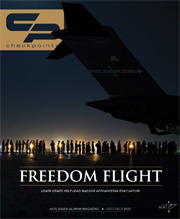
Checkpoints Magazine
December 2021
Air Garden Sprouts Anew

|

